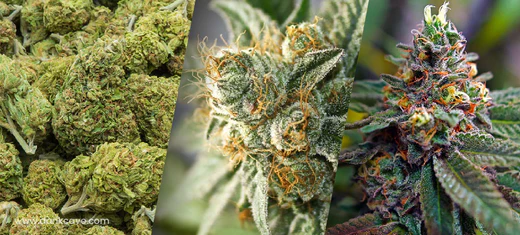August 3rd, 2022 | 6 min read
Best Types of Herbs to Vaporize
Vaporizing herbs has many benefits over smoking or eating them, but knowing which herbs are best to vaporize and why can be difficult, whether it is lavender, ginger, hops, lemon balm, passionflower, sage or any other. This article covers the best herbs to vaporize, including what they are, their potential benefits, and how to get the most out of your vaporize
How to use a dry herb vape?
Dry herb vaping is a great way to enjoy the benefits of herbs without having to smoke them. There are many different dry herbs vape pens on the market, and each works slightly differently. Here are some tips on how to use a dry herb vape pen from the best vape users:
1. Start grinding your herbs into a fine powder using a grinder.
2. Fill the chamber of your vape pen with the ground herbs.
3. Put the mouthpiece of your vape pen in your mouth and inhale slowly.
4. You should see vapor coming out of the chamber after a few seconds.
5. Continue inhaling until you have taken all the vapor you want.
6. Exhale and enjoy.
How do dry herb vapes work?
Dry herb vapes work by heating up your material to a hot temperature to vaporize the active ingredients, but not so hot that it combusts. This process releases the THC, CBD, and other cannabinoids as a gas you can inhale.
Dry herb vapes can heat your material in a few different ways. The most common method is conduction, which involves placing your material directly on the heating element. Some vapes use convection, which heats the air around your material and then forces it through a chamber before you inhale it.
Is vaporizing herbs safe?
You may be wondering if it is safe to vaporize herbs. Many claim that vaping is healthier than smoking, but there’s not enough research to say one way or the other. Vaping produces fewer toxins and is generally easier on your lungs because you’re only breathing in the vapor, not the smoke of a traditional cigarette or marijuana joint. However, we still want to remind you that smoking or inhaling anything is damaging to your lungs.
What is the best temperature to vaporize herbs?
There is a lot of debate out there about what the best temperature is to vaporize herbs. Some people say that lower temperatures are better because they preserve more of the active ingredients in the plant material. Others say that higher temperatures are better because they produce more visible vapor. However, not all the herbs should be vaporized at the same temperature. For example, passionflower will be better vaporized at a certain temperature that might be different for lemon balm or lavender.
Herbs that can be vaped
Several different herbs can be vaped, each with unique benefits. Here are some of the best herbs to vape:
Vaporizing Lavender
Probably the most popular fragrant herb is lavender. It is antiseptic and antibacterial, but also has a wonderful flavor and aroma, and is said to offer relaxing qualities. Due to the calming aroma of their blossoms, these floral plants are common throughout the world and are used in both cooking and meditation. Vaping lavender has been used for its calming effects to treat sleeplessness and relieve discomfort, but not enough studies can prove any benefits yet, so always be careful.
Vaporizing Chamomile
In general, chamomile refers to two important kinds of flowering plants (Matricaria Chamomilla and Chamaemelum Nobile) in the Asteraceae family that is native to Europe and West Asia. The polyphenols and terpenoids found in chamomile flowers are thought to be primarily in charge of the flower’s relaxing properties. Chamomile is popular in herbal teas because of its calming effects and fruity, flowery flavor. When vaped, it can have a similar calming effect but has a little rougher flavor. It tastes better when combined with other calming plants like blue lotus, lavender, or lemon balm.
Vaporizing Basil
The word “basil” derives from the Greek word basilikohn, which means “royal”. The herb has been utilized for millennia due to its supposed therapeutic benefits. Basil’s citrus terpenes are brought to life by vaping, giving it a zesty, sweet lemon flavor. In addition to basil’s potent antioxidant and anti-inflammatory qualities, the benefits are said to be calming and mood-lifting. Basil vaping is most effective in the morning and late in the day. It contains linalool, a terpene that is also present in a number of cannabis strains.
Vaporizing Damiana
Damiana is a Mexican plant that gives your blend a powerful aromatic flavor. The plant has lovely yellow blossoms, but its leaves are what actually contain the active ingredients that have made Damiana famous. According to anecdotal findings, Damiana produces a little buzz, but nothing close to that of cannabis. However, damiana is well known for being a strong aphrodisiac. Vaping it provides a bitter but floral flavor as well as an increase in mood and energy.
Vaporizing Chaga
Chaga is a mushroom type commonly used in traditional Chinese medicine. The herb is believed to boost the immune system, fight inflammation, and help improve digestion. Chaga can be found in many forms, including powders, capsules, and teas. When vaporizing, it is essential to use a low temperature so that the herb does not lose its potential medicinal properties. You can also vaporize it with green tea for a smoother experience.
Vaporizing Astragalus
Astragalus is an excellent choice if you’re looking for an herb to vaporize with a long history of use and plenty of potential health benefits. Astragalus is known for its immune-boosting properties and ability to help protect the liver and fight inflammation.
The root of the plant is used to make tea, which is said to have many benefits. Additionally, some studies have shown that astragalus can help improve heart health and reduce cancer risk, but more in-depth research needs to be conducted to prove any of those claims.
Vaporizing Ginger
Ginger is one of the most popular and well-known plants for its medicinal spices in the world. It has a strong, pungent flavor that can be used to add flavor to food or beverages. Additionally, ginger is known for its medicinal properties and has been used to treat various ailments for centuries.
Some of the potential benefits of ginger include it helps with nausea, motion sickness, morning sickness, and vomiting; it relieves pain from menstrual cramps and reduces inflammation and helps fight infection. However, we do need to reiterate that smoking or inhaling anything is bad for your health, and you should always consult a health practitioner before doing so. More research also needs to be conducted to prove any of those claims.
There is plenty of other herbs you can vaporize, like green tea, hops, coltsfoot, blue lotus, mint, calendula and sage.
Aromatherapy Vaporizer – good for anxiety?
The use of essential oils in aromatherapy is a technique for improving both physical and mental health. When you vaporize essential oils, you can experience their benefits more quickly and effectively than if you apply them topically or diffuse them into the air. Normally, aromatherapy is used to help with stress and anxiety in a natural way.
However, not all aromatherapy vaporizers are created equal: some perform better with specific types of oils. Luckily for you, we’ve done the research, so you don’t have to! Here are a few different types of herbals vapes worth checking out, each of which works best with certain oils:
1) Cannabis Vaporizer
2) Vape Pens
3) Dry Herb Vaporizers
However, like herbs, inhaling oils can be harmful to you, so always consult a health practitioner before doing so, to know all the potential benefits and risks.
What are the benefits and risks when you vaporize herbs?
When you vaporize herbs, you can enjoy many benefits, but also some risks.
· Vaporizing is a very efficient way to use your herbs. You’ll get more active ingredients from your herbs when you vaporize them, and less will be wasted.
· Vaporizing is a very gentle way to consume herbs. This means that it’s less likely to irritate your throat or lungs, and it’s also less likely to cause any unwanted side effects.
· The flavor is more concentrated and intense when you vaporize them, making for a more enjoyable experience.
However, we do need to reiterate our disclaimer for the billionth time and really drive home the point that smoking or vaping herbs of any kind carries inherent health risks, such as long-term lung damage. So if you must absolutely smoke or inhale herb leaves, or even flower petals, always do your research and do so in moderation.
Conclusion
When it comes to vaping herbs, there are a lot of different things that you can do to make the experience more enjoyable. One of the best benefits is adding some additional flavor to your vape juice. This can be done by adding some essential oils or other natural extracts. Another great way to add extra flavor to your vape is using dried herbs.
When deciding what kind of herb to use for vaping, there are a few essential factors to remember. First, if you have never used an herb before and want to try something new for the first time, it would be best if you started with one of the lighter-tasting herbs, such as lavender, chamomile or green tea. Second, peppermint and blue lotus would be an excellent choice if you want something with a little bit more taste but don’t want anything too heavy.
If you also just want to learn more about herbs you can vaporize or smoke, you can check out articles about thyme, eucalyptus, sage, hops, passionflower, and many others right here.


